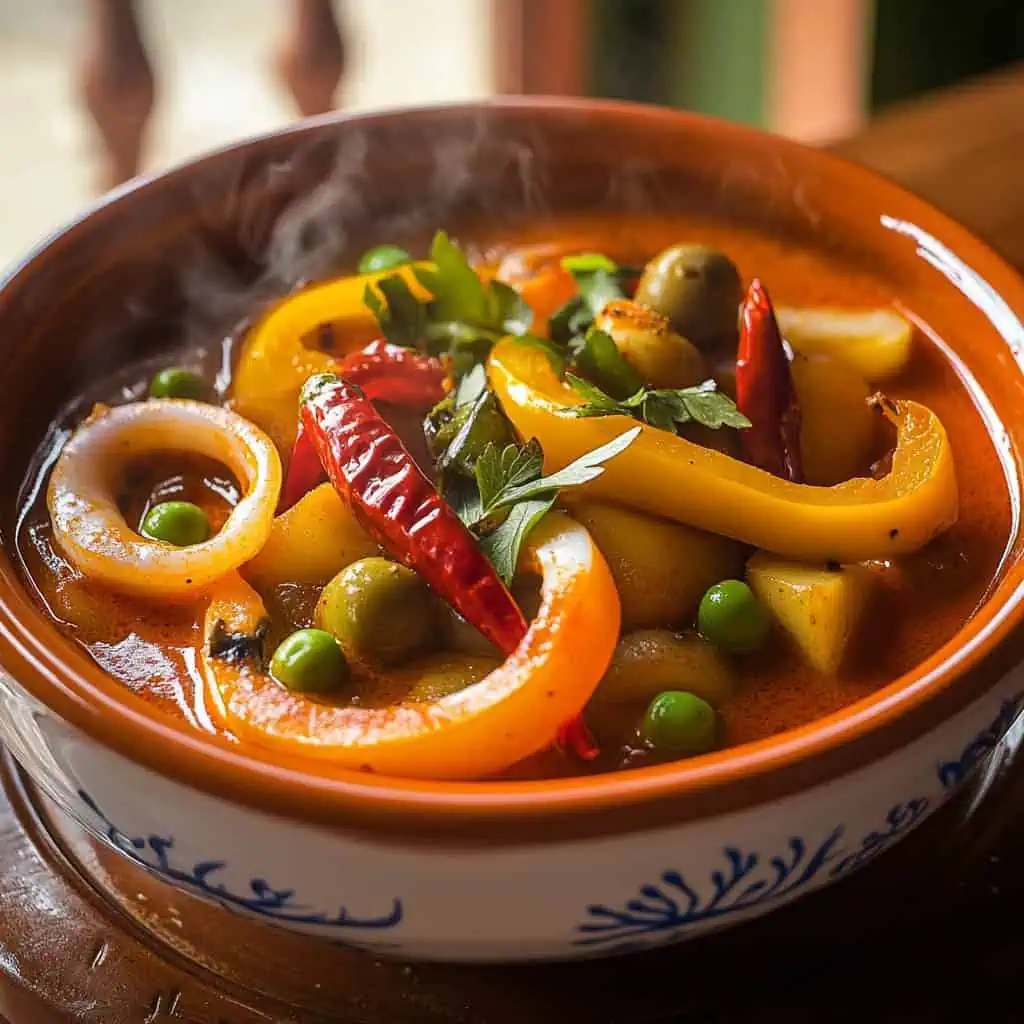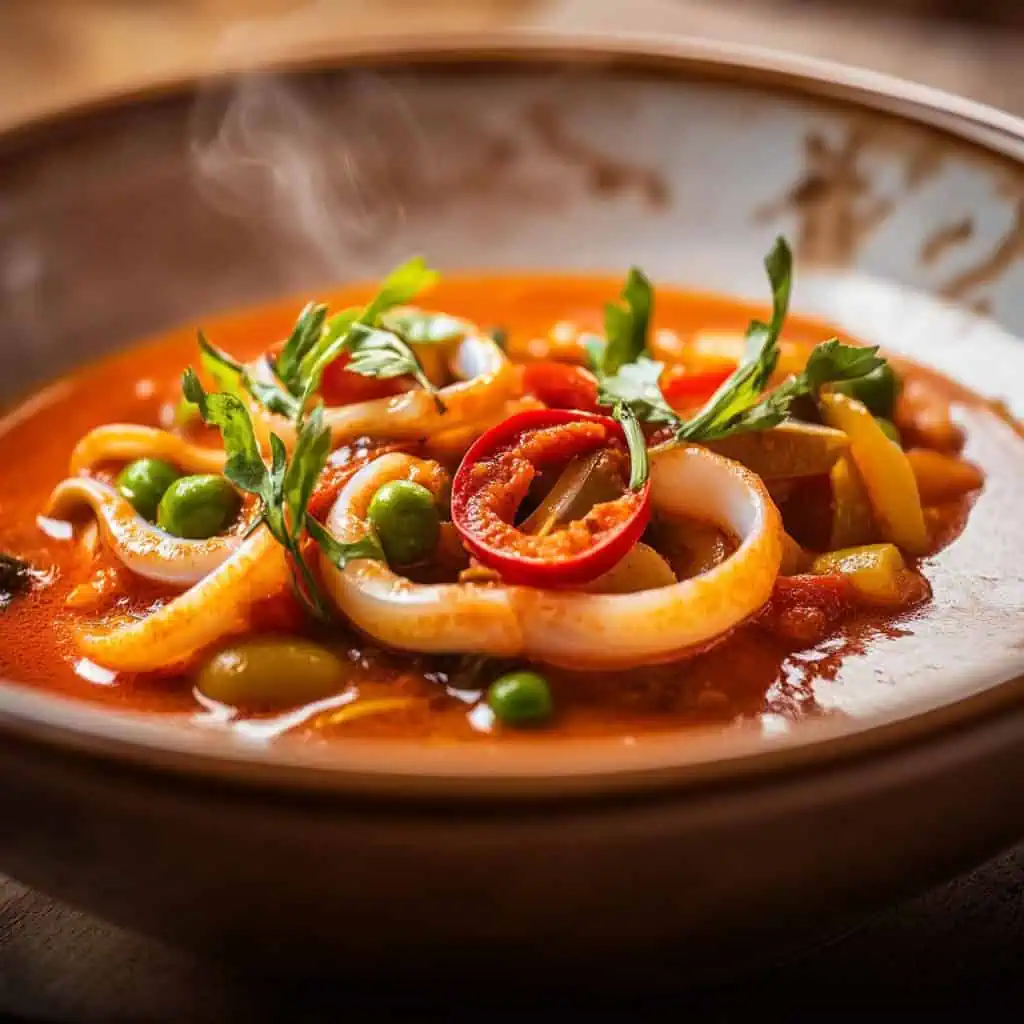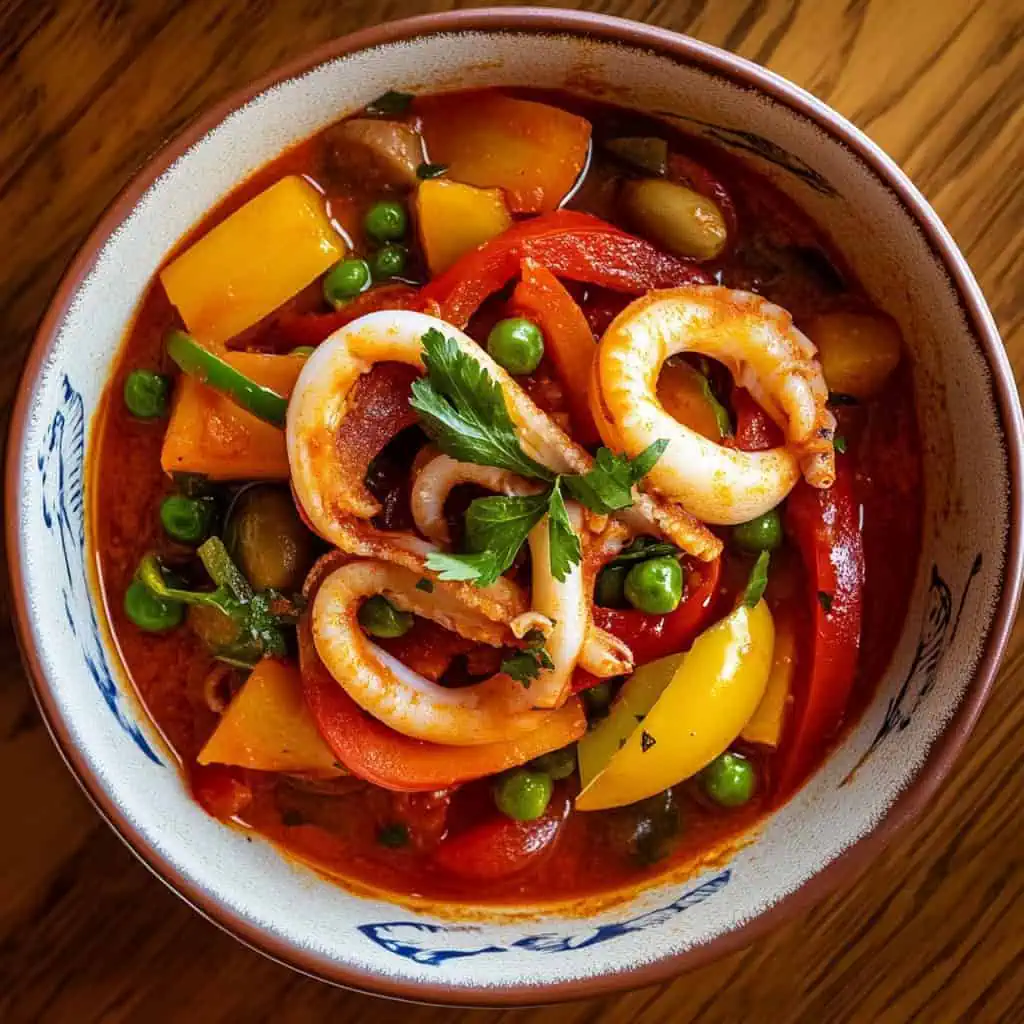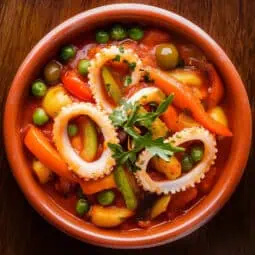I never thought our family's favorite caldereta could get any better until I tried making it with squid! As a busy mom who loves to cook Filipino food, I'm always looking for easier ways to make our classic dishes. This Squid Caldereta changed everything – it cooks faster than beef, costs less, but still has that rich, creamy sauce that makes caldereta so special.
The first time I made this, my kids couldn't believe how tender the squid was, and my husband kept going back for seconds. Even my mother-in-law, who's super traditional with her cooking, asked for the recipe!
If you've been cooking the usual beef caldereta and want to try something new, or if you're looking for a special dish for Friday nights or the Lenten season, this recipe is perfect. It's just as creamy and flavorful as the traditional version, but lighter and quicker to make. Trust me, once you see how easy it is to cook this Squid Caldereta, you'll want to make it again and again.
Cultural Notes
Kaldereta traditionally uses goat or beef, but this seafood version is popular in coastal regions of the Philippines. It's often served during special occasions and family gatherings, especially during the Holy Week when meat is avoided.
Jump to:

Why You'll Love This Recipe
- Ready in under 1 hour
- One-pot meal for easy cleanup
- Budget-friendly seafood option
- Rich and creamy sauce
- Perfect balance of flavors
- Great for both everyday meals and special occasions
- Healthier alternative to meat-based kaldereta
Ingredients
The ingredients in Squid Caldereta showcase the perfect fusion of Spanish and Filipino flavors. Fresh squid forms the foundation as a quick-cooking, tender alternative to traditional beef, while the combination of tomato sauce and liver spread creates the signature rich, complex base that defines caldereta.
Bell peppers and potatoes add hearty texture and absorb the savory flavors, while cheese melts into the sauce for irresistible creaminess. Green peas provide bursts of sweetness, and chilies add just enough heat to balance the dish.
Each component plays a crucial role in delivering that perfect balance of tangy, savory, and slightly spicy flavors that make this coastal adaptation a beloved Filipino comfort food.

- ½ kilo squid, medium sized, cleaned and cut into rings
- ⅓ cup vinegar
- 2 teaspoons salt
- ½ teaspoon black peppercorns, lightly cracked
- ½ tablespoon minced garlic
- 500g tomato sauce
- 1 can (400g) green peas
- 1 medium onion, chopped
- 2-3 tablespoons canola oil
- 1 can (85g) liver spread
- 2 medium bell peppers, seeded and sliced
- 2 pieces long green or red chili
- ⅓ cup bottled olives, drained
- 250g potatoes, cubed
- ½ cup grated cheddar cheese
- Hot chili sauce to taste
Equipment
- Large Heavy-Bottom Pot: Ensures even heat distribution when cooking the stew
- Sharp Knife: Essential for cleaning the squid properly and cutting it into uniform rings
- Cutting Board: Provides a clean surface for preparation work
- Measuring Cups and Spoons: For precise ingredient amounts
- Wooden Spoon: Allows gentle stirring without scratching your pot
- Bowl for Marinating: To properly season the squid before cooking
- Strainer: Helpful when draining the squid after marinating
- Kitchen Timer: Prevents overcooking the squid, which can make it tough

How To Make
- Clean the squid thoroughly under running water. Remove the ink sac, beak, and internal parts, then cut into uniform 1-inch rings. Pat them dry with paper towels.
- Mix vinegar, salt, garlic, and cracked peppercorns in a bowl. Add the squid rings to this mixture and let them marinate for exactly 15 minutes – no longer, or the vinegar will start cooking the squid.
- While the squid marinates, heat oil in a large pot over medium-high heat (350°F/175°C). Fry the potato cubes until golden brown, about 5-7 minutes. Remove them and set aside.
- Using the same pot, lower the heat to medium and sauté the chopped onions until they become soft and clear, about 4-5 minutes. Add the garlic and peppercorns from the squid marinade and cook for another minute until fragrant.
- Add the marinated squid to the pot and stir for just one minute. Pour in the remaining marinade and cook for another minute, stirring gently.
- Pour in the tomato sauce and add the sliced bell peppers. Let it come to a boil, then lower the heat to medium-low (300°F/150°C). Add the fresh chilies and let everything simmer for 5 minutes.
- Stir in the liver spread until it completely dissolves into the sauce. Add back the fried potatoes and the green peas. Let everything simmer until the potatoes are heated through.
- Add the grated cheese and stir until it melts completely into the sauce. Taste and adjust the seasoning with salt and hot chili sauce if you want it spicier.
- Serve hot with freshly cooked rice.

Tips from Lola's Kitchen
- Quick Cooking: Don't overcook the squid - it becomes tough and rubbery when cooked too long
- Fresh is Best: Use fresh, not frozen squid for the best texture and flavor
- Scoring Technique: Score the squid in a crosshatch pattern to help it absorb the marinade better
- Smooth Sauce: Add liver spread gradually while stirring to prevent lumps
- Gentle Handling: Keep stirring gentle to prevent breaking up the squid rings
- Marinade Timing: Watch the clock when marinating - exactly 15 minutes is perfect
- Oil Temperature: Make sure the oil is hot enough when frying potatoes to get them crispy outside
- Sauce Consistency: If you prefer a thicker sauce, simmer uncovered for an extra 5 minutes
- Flavor Development: Let the dish rest for 10 minutes before serving to allow flavors to meld
Substitutions
- Squid: Fresh cuttlefish or baby octopus (adjust cooking time accordingly)
- Liver Spread: Mashed liver pâté or 2 tablespoons tomato paste + 1 tablespoon peanut butter
- Bell Peppers: Roasted red capsicum or mild chilies
- Cheddar Cheese: Processed cheese, queso de bola, or cream cheese
- Green Peas: Young corn, carrots, or green beans cut into small pieces
- Canola Oil: Any neutral vegetable oil or coconut oil for a hint of sweetness
- Tomato Sauce: Crushed tomatoes plus 1 teaspoon sugar
Troubleshooting
Tough, Rubbery Squid
- Cause: Overcooked at too high temperature or for too long
- Solution: Remove from heat immediately and add a splash of cold water
- Prevention: Keep strict timing - squid needs either very quick (2-3 minutes) or very slow cooking (30+ minutes)
Watery Sauce
- Cause: Excess moisture from vegetables or underdeveloped sauce
- Solution: Simmer uncovered to reduce liquid, or mix 1 teaspoon cornstarch with 1 tablespoon water and stir in
- Prevention: Use thick tomato sauce and drain vegetables well
Too Spicy
- Cause: Too many chilies or hot sauce added
- Solution: Add more cheese, a splash of coconut milk, or more potatoes to absorb heat
- Prevention: Add chilies gradually and taste as you go
Sauce Separating
- Cause: High heat or adding cheese too quickly
- Solution: Lower heat and whisk constantly until emulsified
- Prevention: Add cheese off the heat, stirring constantly
Storage & Reheating
- Refrigeration: Store in an airtight container for up to 3 days. The flavor actually improves overnight as the squid absorbs more of the sauce.
- Freezing: While possible for up to 1 month, the texture of squid may change slightly. Freeze sauce and squid separately for best results.
- Reheating on Stovetop: Place in a pot with 2 tablespoons of water, cover, and heat on low, stirring occasionally until just warmed through (about 5 minutes). Avoid boiling as this will toughen the squid.
- Microwave Reheating: Place in a microwave-safe container, cover loosely, and heat on 50% power in 30-second intervals, stirring between each interval. Stop as soon as it's warmed through.

FAQ
Can I use frozen squid?
Yes, but thaw completely and pat dry before using. Fresh squid provides better texture and flavor, but frozen works in a pinch. You may need to reduce cooking time slightly as frozen squid tends to cook faster once thawed.
How do I clean squid properly?
Gently pull the head and tentacles from the body. Remove the transparent quill from inside the body. Peel off the spotted skin, rinse thoroughly, and remove any remaining parts. For detailed cleaning instructions, search for "how to clean squid" online.
Is this recipe spicy?
The basic recipe is mild to medium spicy. The chili peppers add flavor more than heat. Adjust by removing the seeds from the chilies for less heat or adding hot sauce at the end for more spice.
How do I prevent the squid from becoming rubbery?
Cook quickly at high heat (1-2 minutes) or slowly at very low heat (30+ minutes). The danger zone is medium heat for 5-15 minutes, which will almost certainly result in rubber-band texture.
Can I make this in advance for a party?
Yes, but for best results, prepare the sauce with all ingredients except the squid. When ready to serve, quickly cook the marinated squid and add it to the reheated sauce. This prevents overcooking.
What can I serve with Squid Caldereta?
Steamed white rice is traditional. Other good accompaniments include garlic rice (sinangag), ensaladang mangga (green mango salad), or some crusty bread for dipping in the sauce.
Is this dish suitable for the Lenten season?
Yes, it's a perfect seafood alternative during Holy Week or any time when meat is avoided.
Can I use other seafood?
Yes! Try a mixed seafood caldereta with shrimp, mussels, and firm white fish. Adjust cooking times accordingly - add quick-cooking seafood like shrimp in the last few minutes.
How do I know when the squid is perfectly cooked?
Perfectly cooked squid turns from translucent to opaque white with a slight firmness. If you can easily cut through it with the side of a spoon, it's done. If it resists, it's overcooked.
Can I make this dish less rich?
Yes, you can reduce the amount of liver spread and cheese, though this will change the authentic flavor. Consider using light cream cheese instead of full-fat cheddar.
Related
Looking for other recipes like this? Try these:

Filipino Squid Caldereta (Kalderetang Pusit)
Equipment
- Large Heavy-Bottom Pot (Kaldero) For even heat distribution
- Sharp knife (kutsilyo) For cleaning squid and chopping vegetables
- Cutting board (Sangkalan) For preparation
- Measuring cups and spoons (Panukat) For accurate measurements
- Wooden spoon (sandok) For stirring without scratching the pot
- Bowl for marinating To hold squid mixture
- Strainer [Salaan] For draining squid
- Kitchen Timer To ensure perfect cooking time
Ingredients
For the Squid:
- ½ kilo Squid Pusit, medium sized, cleaned and cut into rings
- ⅓ cup vinegar suka
- 2 teaspoons salt asin
- ½ teaspoon black peppercorns paminta, lightly cracked
- ½ tablespoon minced garlic bawang
For the Sauce:
- 500 g Tomato Sauce
- 1 can 400g Green Peas gisantes
- 1 medium onion sibuyas, chopped
- 2-3 tablespoons Canola oil mantika
- 1 can 85g Liver Spread
- 2 medium Bell Peppers bell pepper, seeded and sliced
- 2 pieces long Green or Red chili sili
- ⅓ cup bottled olives drained
- 250 g Potatoes patatas, cubed
- ½ cup grated cheddar cheese keso
- Hot Chili Sauce to taste
Instructions
- Start by cleaning the squid thoroughly under running water. Remove the ink sac, beak, and internal parts, then cut into uniform 1-inch rings. Pat them dry with paper towels.
- Mix vinegar, salt, garlic, and cracked peppercorns in a bowl. Add the squid rings to this mixture and let them marinate for exactly 15 minutes – no longer, or the vinegar will start cooking the squid.
- While the squid marinates, heat oil in a large pot over medium-high heat (350°F/175°C). Fry the potato cubes until golden brown, about 5-7 minutes. Remove them and set aside.
- Using the same pot, lower the heat to medium and sauté the chopped onions until they become soft and clear, about 4-5 minutes. Add the garlic and peppercorns from the squid marinade and cook for another minute until fragrant.
- Add the marinated squid to the pot and stir for just one minute. Pour in the remaining marinade and cook for another minute, stirring gently.
- Pour in the tomato sauce and add the sliced bell peppers. Let it come to a boil, then lower the heat to medium-low (300°F/150°C). Add the fresh chilies and let everything simmer for 5 minutes.
- Stir in the liver spread until it completely dissolves into the sauce. Add back the fried potatoes and the green peas. Let everything simmer until the potatoes are heated through.
- Add the grated cheese and stir until it melts completely into the sauce. Taste and adjust the seasoning with salt and hot chili sauce if you want it spicier.
- Serve hot with freshly cooked rice. The entire cooking process should take about 45 minutes, and this recipe serves 4-6 people.
Tips from Lola's Kitchen
- Don't overcook the squid - it becomes tough and rubbery when cooked too long
- Use fresh, not frozen squid for best results
- Score the squid in a crosshatch pattern to help it absorb the marinade better
- Add liver spread gradually while stirring to prevent lumps
- Keep stirring gentle to prevent breaking up the squid rings
Nutrition
The Story Behind Squid Caldereta
Caldereta, also spelled kaldereta, has humble beginnings as a Spanish-influenced Filipino dish traditionally made with goat or beef. Its name comes from the Spanish word "caldera," meaning cauldron, referring to the large pot used to slow-cook tough meat until tender. But along the coastal regions of the Philippines, particularly in areas where fresh seafood is abundant, local cooks began experimenting with this beloved recipe.
In provinces like Batangas, Cavite, and Mindoro, where fishing communities thrive, innovative home cooks started adapting caldereta using the seafood readily available to them. Squid (pusit) became a popular choice because of its natural tenderness and ability to absorb the rich flavors of caldereta's signature sauce. This seafood version emerged as a practical alternative during the Lenten season when many Filipino Catholics abstain from meat.
What makes Squid Caldereta truly special is how it maintains the dish's core elements – the creamy tomato-based sauce enriched with liver spread, the tender potatoes, and colorful bell peppers – while introducing the natural sweetness of fresh squid. Unlike the traditional version that requires hours of cooking to tenderize tough meat, this seafood adaptation comes together in under an hour, making it a practical choice for modern Filipino families.
Today, Squid Caldereta has earned its place in Filipino cuisine as more than just a Lenten alternative. You'll find it served at beach-side restaurants, family gatherings, and even at special occasions alongside traditional meat versions. Its popularity has grown as more people discover how this coastal innovation offers the same comforting flavors of traditional caldereta but with a lighter, seafood twist that's perfect for contemporary tastes.
Whether you're looking to explore Filipino cuisine, need a quick yet impressive dish for guests, or want to try a healthier version of the classic caldereta, this squid version proves that some of the best recipes come from creative adaptations of traditional favorites. The dish perfectly represents how Filipino cooking continues to evolve while honoring its historic roots and cherished flavors.










Comments
No Comments